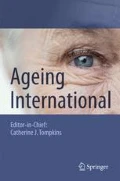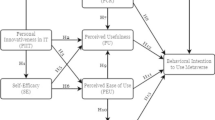Abstract
When we think of technology-savvy consumers, older adults are typically not the first persons that come to mind. The common misconception is that older adults do not want to use or cannot use technology. But for an increasing number of older adults, this is not true (Pew Internet and American Life Project 2003). Older adults do use technologies similar to their younger counterparts, but perhaps at different usage rates. Previous research has identified that there may be subgroups of older adults, “Silver Surfers”, whose adoption patterns mimic younger adults (Pew Internet and American Life Project 2003). Much of the previous research on age-related differences in technology usage has only investigated usage broadly—from a “used” or “not used” standpoint. The present study investigated age-related differences in overall usage of technologies, as well as frequency of technology usage (i.e., never, occasional, or frequent). The data were gathered through a questionnaire from younger adults (N = 430) and older adults (N = 251) in three geographically separate and ethnically diverse areas of the United States. We found that younger adults use a greater breadth of technologies than older adults. However, age-related differences in usage and the frequency of use depend on the technology domain. This paper presents technology usage and frequency data to highlight age-related differences and similarities. The results provide insights into older and younger adults’ technology-use patterns, which in turn provide a basis for expectations about knowledge differences. Designers and trainers can benefit from understanding experience and knowledge differences.







Similar content being viewed by others
References
Centers for Disease Control (2009). Health characteristics of adults aged 55 years and over: United States, 2004–2007. Available via Centers for Disease Control. http://www.cdc.gov/nchs / data/nhsr/nhsr016.pdf. Cited 7 April 2010.
Charness, N., Fox, M., & Mitchum, A. (2010). Lifespan cognition and information technology. In K. Fingerman, C. Berg, T. Antonnuci, & J. Smith (Eds.), Handbook of lifespan psychology. New York: Springer.
Czaja, S. J., Sharit, J., Charness, N., Fisk, A. D., & Rogers, W. A. (2001). The Center for Research and Education on Aging and Technology Enhancement (CREATE): a program to enhance technology for older adults. Gerontechnology, 1, 50–59.
Fisk, A. D., Rogers, W. A., Charness, N., Czaja, S. J., & Sharit, J. (2009). Designing for older adults: Principles and creative human factors approaches (2nd ed.). Boca Raton: CRC Press.
Gallup, A. M., & Newport, F. (2007). The Gallup Poll, Public Opinion 2005. Maryland: Rowman & Littlefield, Publishers, Inc.
International Standards Organization. (2006). Ease of operation of everyday products—Part 1: Design requirements for context of use and user characteristics [ISO Standard 20282-1:2006(E)]. Geneva: International Standards Organization.
Kaiser Family Foundation (2005, January). E-health and the elderly: How seniors use the internet for health information (Research Report No. 7223). Available via Kaiser Family Foundation. http://www.kff.org/ entmedia/upload/. Cited 17 December 2007.
Mitzner, T. L., Boron, J. B., Fausset, C. B., Adams, A. E., Charness, N., Czaja, S. J., et al. (2010). Older adults talk technology: their usage and attitudes. Computers in Human Behavior, 26(6), 1710–1721.
O’Hanlon, A., Bond, R., Knapp, B., & Carragher, L. (2010). The Nestling Project: attitudes toward technology and associations with health, relationships, and quality of life. Gerontechnology, 9(2), 236.
Pew Internet and American Life Project. (2003, November 23). Consumption of information goods and services in the United States. Available via Pew Internet and American Life Project. http://www.pewinternet.org/pdfs/PIP_Info_Consumption.pdf. Cited 3 February 2008.
Pew Internet and American Life Project. (2004, March). Older adults and the Internet. Available via Pew Internet and American Life Project. http://www.pewinternet.org/PPF/r/117/report_display.asp. Cited 3 February 2008.
Pew Internet and American Life Project. (2005, October). The future of the Internet as baby boomers age. Available via Pew Internet and American Life Project. http://www.pewinternet.org/Presentations/2005/The-Future-of-the-Internet-as-Baby-Boomers-Age.aspx. Cited 3 February 2008.
Pew Internet and American Life Project. (2007, October). E-patients with a disability or chronic disease. Available via Pew Internet and American Life Project. http://www.pewinternet.org//PPF/r/222/report_display.asp. Cited 10 March 2010.
Pew Internet and American Life Project. (2008, May). Cloud computing, politics, and adult social networking. Available via Pew Internet and American Life Project. http://pewinternet.org/Shared-Content/Data-Sets/2008/May-2008--Cloud-computing-politics-and-adult-social-networking.aspx [data file]. Cited 10 March 2010.
Pew Internet and American Life Project. (2009, January). Generations online in 2009. Available via Pew Internet and American Life Project. http://pewinternet.org/Reports/2009/Generations-Online-in-2009.aspx. Cited 10 March 2010.
Pfeiffer, R. I. (1975). A short portable mental status questionnaire for the assessment of organic brain deficit in elderly patients. Journal of the American Geriatrics Society, 23, 433–444.
Rogers, E. M. (2003). Diffusion of innovations (5th ed.). New York: Free Press.
Selwyn, N., Gorard, S., Furlong, J., & Madden, L. (2003). Older adults’ use of information and communications technology in everyday life. Aging and Society, 23, 561–582.
Taha, J. T., Sharit, J., & Czaja, S. (2009). Use of and satisfaction with sources of health information among older adult Internet users and nonusers. The Gerontologist, 49(5), 663–674.
Wechsler, D. (1997). Wechsler Memory Scale III (3rd ed.). San Antonio: The Psychological Corporation.
Author information
Authors and Affiliations
Corresponding authors
Additional information
This research was supported in part by a grant from the National Institute of Health (National Institute on Aging) P01 AG017211 under the auspices of the Center for Research and Education on Aging and Technology Enhancement (CREATE; www.create-center.org). The research was conducted in compliance with the current laws of the country and was approved by the appropriate ethics committees.
Rights and permissions
About this article
Cite this article
Olson, K.E., O’Brien, M.A., Rogers, W.A. et al. Diffusion of Technology: Frequency of use for Younger and Older Adults. Ageing Int 36, 123–145 (2011). https://doi.org/10.1007/s12126-010-9077-9
Published:
Issue Date:
DOI: https://doi.org/10.1007/s12126-010-9077-9




